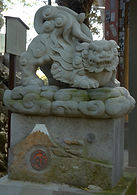普通の外にいくつかの著名な品質を持っている、と畏敬の念を起こさせるあるいかなるビーイングは、カミと呼ばれています。
Nearest station
Shimbamba
Keikyu Line
Tōkyō-to, Shinagawa-ku. Kitashinagawa 3-7-15
東京都品川区北品川3-7-15
品川神社
Shinagawa Jinja
Dec 29, 2016
Home page: (Japanese)
History
Legend has it that in 1185, the third year of the Bunchi Era, Minamoto no Yoritomo, the first of the Kamakura shoguns, ordered the construction of a sub-shrine with the replication of the tutelary deity of the Sunosaki Myōjin 洲崎明神 in Awa Province (located in the current Chiba-ken) on the site of what is now Shinagawa Jinja. The deity enshrined at the site, then and now, is Amenohirime-no-mikoto, is the kami of maritime safety. In 1319 and 1429 benefactors funded improvements of the shrine. In 1591 Tokugawa Ieyasu granted the shrine some income producing land; later the nearby Minami-kibune Jinja (now Ebara Jinja) protested and it was given half of the land which Ieyasu had granted Shinagawa Jinja. In 1637 a Buddhist temple, Tōkai-ji, was built to the south of the shrine, and the shrine had to give up some land to the new temple. In return it was given some in front of the temple. Along with this, the shrine’s location to the north-east of the temple—in Yin-Yang thinking the northeast is considered to be unlucky (kimon)—caused the third of the Tokugawa shoguns, Iemitsu, to decree that it become the tutelary god of the temple. In recognition of this the bakufu government accepted responsibility for maintaining a large part of the shrine grounds. Later shoguns enabled rebuilding of the main hall in 1695 and again in 1851. In 1868 Emperor Meiji visited the shrine and designated it as one of the twelve major Tōkyō shrines, now the Ten Tōkyō Shrines.
Description
A 3-4 minute walk from the north exit of Shimbamba Station. Not only is Shinagawa Jinja one of the Ten Tōkyō Shrines but it is also one of the Tōkai Shichi Fukujin (Tōkai Seven Lucky Gods) and the kami it is associated with in this context is Daikokuten. it can also boast of what is, at 15 metres in height, probably
Enshrined Deities:
Main
天比理乃咩命 Amenohirime-no-mikoto
From Merged Shrines
素盞嗚尊 Susanoo-no-mikoto
宇賀之売命 Uka-no-hime-mikoto
In-ground Shrines:
御嶽神社 Mitake Jinja
清滝弁財天社 Benten Sha
阿那稲荷社 Anainari Sha
猿田彦神社 Sarutahiko Jinja
浅間神社 Sengen Jinja
Earliest mention of: 1185
Annual Festival: Nearest Friday/Saturday/Sunday to June 7




the largest Fujizuka in Tokyo. It was built in 1869 and the torii signifying the entrance to the mound is about halfway up the stone staircase leading to the main torii of the shrine. There are two jinja on this Fujizuka, one is a Sengen Jinja, the other a Saruta-hiko Jinja. This latter is quite small and easy to miss: it is on the right-hand side at the bottom of the small stairway leading up to the peak of the mound. Moving away from the Fujizuka the Anainari Jinja, to the right of the main hall of the shrine facing towards it, is very interesting and well worth a visit in its own right.






















